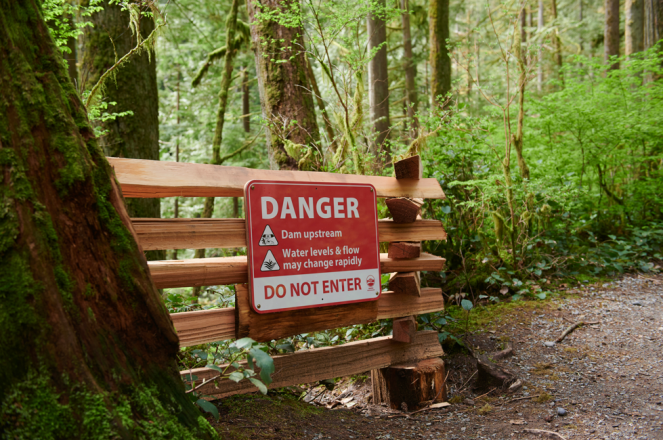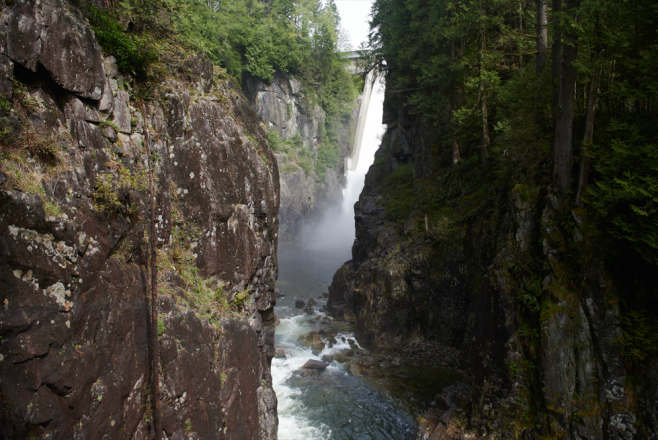Metro Vancouver is stepping up efforts to enhance public safety around one of the region’s most beloved natural destinations—the Capilano River. Through its River Safety campaign, Metro Vancouver is empowering park visitors with vital knowledge about the unpredictability of the Capilano River and how to stay safe in the event of an emergency.
The Capilano River, which flows through Capilano River Regional Park, is fed by the Cleveland Dam and Capilano Reservoir—critical parts of the regional drinking water system. While the area is a popular destination for activities such as hiking, running, fishing, and swimming, the beauty of the river can also mask the very real dangers posed by sudden changes in water levels.
“This river is unique because of the tall and narrow ravine it travels through. The water levels can change very quickly and we have safety measures in place in case an emergency at the dam causes water levels to rise quickly,” says Daniel Roberge, deputy general manager of operations, Water Services at Metro Vancouver. “Our campaign brings attention to the risks of the river and reminds people to both be aware of their surroundings while in the area and to stay on sanctioned park trails.”
Enhancing awareness to enjoy nature safely
Metro Vancouver’s River Safety campaign runs every spring in alignment with Emergency Preparedness Week. The goal is to help people enjoy nature safely by educating them about the potential risks—particularly around fast-changing river conditions caused by dam operations.
Heavy rainfall or controlled releases of water from the Cleveland Dam can dramatically raise river levels, making it hazardous for anyone near the riverbed. These releases may be necessary for operational or emergency reasons and can happen any time of year.
“In focus testing, we heard that people don’t think of the water itself as risky,” says Roberge. “They are more likely to think of wildlife, hypothermia or getting lost. The river itself can be very fast and rise quickly — something that could catch people off guard, particularly if they’ve gone off the trails.”
A multi-layered approach to river safety
Metro Vancouver has implemented a number of upgrades as part of its Dam Safety Enhancements Program. This includes signage along the Capilano River, enhanced public warning systems like audible alarms and strobe lights, and targeted educational outreach in Capilano River Regional Park.
“As part of our commitment to dam safety, we’ve introduced new safety procedures, updated public warning systems and completed in-depth studies of the Capilano River,” notes Roberge. “We’re also working closely with Sḵwx̱wú7mesh (Squamish Nation), səlilwətaɬ (Tsleil-Waututh Nation), municipalities and emergency partners—including during our largest-ever table-top safety exercise—to strengthen public safety now and into the future.”
The upgrades aim to provide clear, accessible instructions on how to respond during an emergency, especially in areas where risk is greatest. Signs in multiple locations now provide guidance on moving to higher ground in the event of an alarm, and Metro Vancouver continues to work with local partners to build community awareness.
Keeping safety top of mind
Capilano River Regional Park spans the Districts of North Vancouver and West Vancouver, drawing thousands of visitors each year. With its forested trails, tranquil pools and dramatic canyon views, it’s easy to see why people flock to this area. But as Metro Vancouver reminds residents and tourists alike: enjoying nature comes with responsibility.
The most important things visitors can do to stay safe around the Capilano River are staying on trails and following all signage. If you hear the alarm, get away from the river as quickly as possible. And you can also download the Alertable app, which provides public safety notification for Cleveland Dam.
“Public education is at the heart of this campaign,” says Roberge. “Remember, walking the park trails along the river and in the park are the safest ways to experience the park. Swimming, fishing and kayaking are discouraged because the river can be unpredictable.”
To learn more about Metro Vancouver’s River Safety campaign and the Dam Safety Enhancements Program, visit metrovancouver.org/river-safety.




